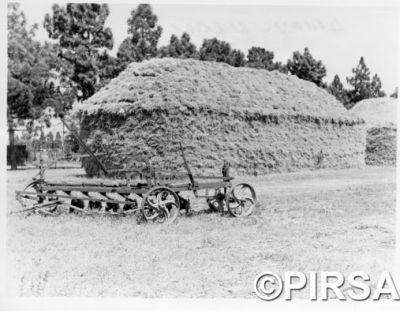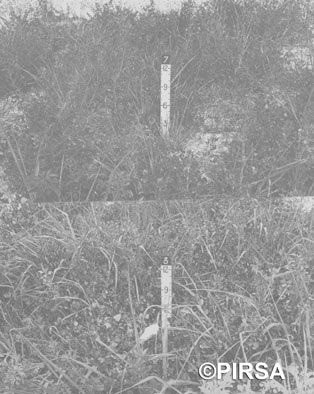Pastures
In the initial stages cattle were run on large estates or pastoral runs from Mt Gambier in the south to the ever expanding northern zone of the state. Scanning the articles in 'Pastoral Pioneers of South Australia' (Various Government Statistical Registrars and Livestock Statistical publications) gives a detailed insight of the scale and approach taken prior to the 1940s. In the inside country many of these large properties were later subdivided into smaller properties (including soldier settler blocks), running predominantly sheep or converted to mixed cereal farming. Extensive land development and improved pastures expanded the carrying capacity of the South East of the State in the 1950s and 60s leading to increased numbers, with the result that today about 50% of the cattle are run in the higher rainfall country, 25% in the cereal belt and 25% in the northern pastoral area.

Photo No.: 103256 Title: Hay stack, Pine drive, Northfield Research Centre 1963. Date: 1963
The State and Commonwealth governments’ War Service Land Settlement program not only saw land being reallocated but the State government also played a role in developing areas of the State. Research into trace elements and subterranean clover enabled vast areas of previously infertile mallee scrub, heath and lateritic soil country to be brought into agricultural production in the South East, Kangaroo Island and southern Eyre Peninsula. One area of 160,000 ha in the Upper South East, the so-called Ninety-Mile Desert, was taken up as a private development by the AMP Society in the 1950s, thus Coonalpyn Downs was established with the stocking rates of sheep and cattle increasing dramatically. In the 1980s they were devastated when blue green aphid devastated the lucerne in the area.

Photo No.: 106576 Title: Applying Copper Sulphate and Zinc to correct soil deficiencies, enhances the growth of this Sub Clover crop at Coonalpyn Downs, seen in the lower frame (photo from D. S. Riceman, CSIRO). Date: c.1950
A paper summarising the extensive research work in this area is Trace Element disorders in South Australian Agriculture (). It provides a chronological evaluation of South Australian research into trace elements such Co, Cu, Se, Mo, and S and their interaction in livestock and pastures.
Work at Kybybolite Experimental Farm, near Naracoorte, demonstrated the substantial improvement in pasture production achieved with subterranean clover, various grasses and superphosphate. (Geytenbeek P, Kybybolite Experimental Farm - a History (), P16 (2003)). It was not until the early 1950s that beef cattle were introduced and any pasture work related to grazing cattle was initiated.
